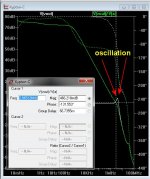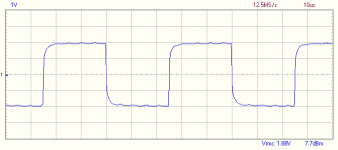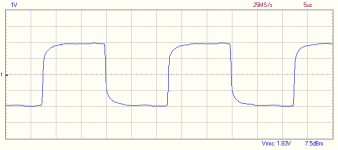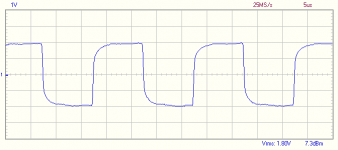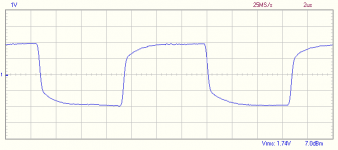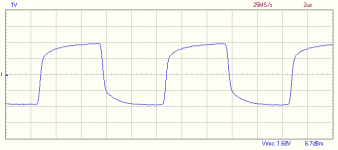It's actually just as fun for me when things don't work. I'm figuring out audio circuits. I ordered a bunch of MT-200 outputs from Newark and they forgot to send thermal pads so they credited me for the transistors and told me to throw them out. Free outputs to fry!
It's actually just as fun for me when things don't work. I'm figuring out audio circuits. I ordered a bunch of MT-200 outputs from Newark and they forgot to send thermal pads so they credited me for the transistors and told me to throw them out. Free outputs to fry!
Blow those ? I don't think so !
I sent caps a flying (pop !) blew the rail fuses - MT-200's don't care . The
DC SOA of 3 pairs is close to the current rating of the PCB traces themselves. 😱
OS
"I'm using those red wima .1uf's ..."
I've always had good luck with those WIMAs. I would be very surprised if those are the problem.
I've always had good luck with those WIMAs. I would be very surprised if those are the problem.
I'm using those red wima .1uf's and those "no-name" blue's you sent me ...
I notice no issues ??? This would not cause oscillation ?
OS
The blue ones are Epcos. I was wondering about possible noise on the supply, not the oscillation. I think R15 and R16 might be what tames that. I'll see tonight.
Hi OS do you mean that we must ommit this R8 from Kypton C?I just measured my blues (ones you ordered-kingsbright). 2.67V Vf.
This stays quite steady , unless you subject to 0-40C temperature swings.
If they light up the same they should drop the same Vf. As they heat the Vf
should drop a little ... (2.5+ - 2.6) , and current through R25/33K should increase.
R25 Voltage went from 68- <70V as I closed the front door to let this IPS
get warmer.
On this and any of the 5-6ma VAS's ... you do not need any heatsink.
They still run cool , even when I was running in my toasty amp case.
I DID add a very small piece of flashing cut with scissors to all the IPS's ,
just in case.
This is fun 😎 . (when things work , that is).
Simulator shows 84mv offset with no servo - that's what I had (86mv)
and nanovolt offset without R8 - this is what I have now.
Simulator matches the real deal almost exactly !!
OS
just swapped the wolverine with .65V across it's 120R CCS Re (5.42ma).
Same OPS I posted , same range of VAS I. The OPS reads EXACTLY the same
15mv bias with the wolverine.
Wolverine offset (2-3mv) is nowhere near the servo'ed precision of the kypton . 🙁
I don't know , both seem to be "right on the money". Neither deviate from
their 63V simulations in euther currents or voltage readings - at all !!
The OPS showed absolutely no deviation considering the swap of
2 totally different IPS's ???
OS
Same OPS I posted , same range of VAS I. The OPS reads EXACTLY the same
15mv bias with the wolverine.
Wolverine offset (2-3mv) is nowhere near the servo'ed precision of the kypton . 🙁
I don't know , both seem to be "right on the money". Neither deviate from
their 63V simulations in euther currents or voltage readings - at all !!
The OPS showed absolutely no deviation considering the swap of
2 totally different IPS's ???
OS
Hi OS do you mean that we must ommit this R8 from Kypton C?
No (won't blow up) , but it really does nothing. Only if you "railed" the servo ,
it might reduce the resulting offset. offset goes down even further without it.
simulator shows input currents will stay 1.2ma without it , as well.
Thimios , you saw nothing oscillate on the Kypton C ???
It looked good on your scope pictures.
Mine seems to be "textbook" , I only had to get the reversed LED and the R6
right (made BOTH mistakes 😱).
OS
Last edited:
This happen even to good families😀No (won't blow up) , but it really does nothing. Only if you "railed" the servo ,
it might reduce the resulting offset. offset goes down even further without it.
simulator shows input currents will stay 1.2ma without it , as well.
Thimios , you saw nothing oscillate on the Kypton C ???
It looked good on your scope pictures.
Mine seems to be "textbook" , I only had to get the reversed LED and the R6
right (made BOTH mistakes 😱).
OS
Kypton C 40V operation.
Not rail independent.
different combinations of R22/27 and R20/21 will give the target 7.7ma
for R22 Re.
Possible combinations are
47R(R22/27) and 680R for R20/21 - 40V operation..
68R and 470R - 63V operation
Those last values should hold for >70V operation , as the trimmer (LEDS) can
reduce Cascode I.
Different LED's could also change the proportion of current between
LED and cascode. R22 and R25 voltages plus Ohm's law is your friend , in this case.
Oh , Jeff ..... 1K as R15/16 make for a "fat" peak at 2-3mhz and the amp
shows marginal stability with very little phase margin (below).
2.2-2.4K + 68/82R is ideal - margin wise.
OS
Not rail independent.
different combinations of R22/27 and R20/21 will give the target 7.7ma
for R22 Re.
Possible combinations are
47R(R22/27) and 680R for R20/21 - 40V operation..
68R and 470R - 63V operation
Those last values should hold for >70V operation , as the trimmer (LEDS) can
reduce Cascode I.
Different LED's could also change the proportion of current between
LED and cascode. R22 and R25 voltages plus Ohm's law is your friend , in this case.
Oh , Jeff ..... 1K as R15/16 make for a "fat" peak at 2-3mhz and the amp
shows marginal stability with very little phase margin (below).
2.2-2.4K + 68/82R is ideal - margin wise.
OS
Attachments
Last edited:
The puzzle fits perfect.R15 and R16 was a good guess then.
That "peak" also causes bad ringing on squarewaves or outright oscillation.
Funny how it falls right in the offending 2+ mhz range.
Oh , your global gain would only be 1/2 normal (not too loud).
OS
I ended up with 68R for R22/27 and 470R for R20/21 for 40 volt rails. It's much more stable now and lots more gain.
I ended up with 68R for R22/27 and 470R for R20/21 for 40 volt rails. It's much more stable now and lots more gain.
Lets see some squares !
I knew , it's essentially a CFA-X floating on servo'ed mirrors with
a bad ar$e VAS attached.
You were out at the end of it's "rope" with
a 3mhz unity gain point. Now it's 1.6mhz with a nice 90 degree margin. 🙂
OS
I've still got a slight glitch happening. I'll post a couple screen shots in the morning. There's still a little upscale 500kHZ tick on the waveform . It's very low voltage. I don't know if it's an issue or not.
it has been some time since i last visited the thread. so, are you saying that Kypton-C is facing stability problems?
it has been some time since i last visited the thread. so, are you saying that Kypton-C is facing stability problems?
My output board combination was unstable. Kypton-C is stable if you find the correct schematic.
That low level oscilation I was seeing last night has disappeared. I'm using a cheap USB scope so that may be part of the issue. Here are some square waves into a 4 ohm dummy load. 20kHz, 40kHz,50kHz, 75kHz, 100khz
Attachments
Last edited:
That low level oscilation I was seeing last night has disappeared. I'm using a cheap USB scope so that may be part of the issue. Here are some square waves into a 4 ohm dummy load. 20kHz, 40kHz,50kHz, 75kHz, 100khz
I am glad to see your kypton is working fine, can't wait to build mine boards🙂
Can you calculate the slewrate (20khz, square) ?
My output board combination was unstable. Kypton-C is stable if you find the correct schematic.
No , your original OP board was OK. 1K feedback resistors would make
any of my CFA's oscillate ! And 10K servo returns would make any servo'ed
amp not servo 😀 .
I'm restuffing my 2'nd main amp now that blew all it's 35V 🙁 😱😱 caps
(at 73V). these OPS's are the toughest "wardogs" around.
Your kypton C layout is absolutely stellar (except for screen errors). It's
grounding is better than my toner version. These Kyptons are PERFECT !
PS- my posted Kypton C schema is absolute - It's what I'm braggin' about now -
perfection in real life ( working amp playing music in front of me).
OS
I am glad to see your kypton is working fine, can't wait to build mine boards🙂
Can you calculate the slewrate (20khz, square) ?
Kypton C slewrate is a little higher than the CFA-X (faster VAS).
<300V/us. This is limited by the input HF filter cap (C2/150p).
The C is just a perfected VSSA - thermally and electrically , acts just
like the wolverine or spooky - I'm quite pleased now that I've built it (first CFA
I ever built).
OS
- Home
- Amplifiers
- Solid State
- Slewmaster - CFA vs. VFA "Rumble"
